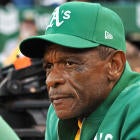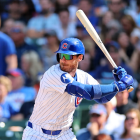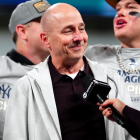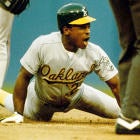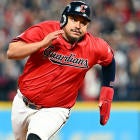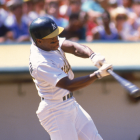The Chicago Cubs smoked the Cleveland Indians 9-3 in Game 6 of the World Series, setting up a Game 7 for the ages.
Tuesday night's contest was all but over just a few minutes in, and was totally salted away by the third inning. For that, the Cubs could thank an offensive outburst that delighted the visiting faithful, and a highlight reel of terrific pitches by Jake Arrieta.
The onslaught started in the first inning. After red-hot soft-tosser Josh Tomlin made quick work of Dexter Fowler and Kyle Schwarber, he got ahead of Kris Bryant 0-2, and looked ready to close out a sparkling opening frame.
Tomlin's calling card is command. After posting an ugly 4.89 ERA with a league-leading 35 homers allowed through the first five months of the season, Tomlin became unhittable thereafter, flashing a 1.93 ERA and allowing just one long ball since Sept. 1. But the pitcher who'd made a living out of painting corners and mixing pitches perfectly over the past two months delivered a gigantic meatball to the likely National League Most Valuable Player, hanging an 0-2 curve that Bryant walloped to Akron.
Everything unraveled quickly from there. Anthony Rizzo and Ben Zobrist both stroked solid singles, the latter coming on another hanging curve. Addison Russell then lofted a flyball to right-center that should have ended the threat. But Tyler Naquin and Lonnie Chisenhall got their signals crossed, allowing the ball to fall between them for a two-run "double." The two-run blow crushed the Indians' hopes, while also reminding us that baseball's conventions for counting errors are dumb, and that ERA can be a silly stat.
The Cubs put the game to bed in the third. After a leadoff Kyle Schwarber walk and a near-second defensive disaster by Naquin (who fell down as Chisenhall cut in front of him to catch a Bryant pop-fly), Cleveland manager Terry Francona called the bullpen to get skilled right-handed reliever Dan Otero loose. Tomlin stayed in the game as Rizzo laced another solid single, and stayed even longer as Zobrist smacked another. Otero was so good this year, he'd held both right- and left-handed hitters to numbers that resembled that of a decent-hitting pitcher. This being the postseason, craziness ensued anyway.
They call that an #AddiSlam. pic.twitter.com/7pc3CLfQxT
— MLB (@MLB) November 2, 2016
Staked to a 7-0 lead, Arrieta cruised to a win. And while he carried a no-hitter into the sixth in Game 2, you could argue he did a better job of executing his pitches in Game 6.
Just as Tomlin ran into trouble almost right away, Arrieta started dealing right away. He gunned a 1-2 fastball by Carlos Santana to lead off the bottom of the first, ringing up his first strikeout on a 97-mph heater, his second-hardest pitch of the entire 2016 season. His fastball kept working as he pitched deeper into the game. An 0-2 heater to Jose Ramirez came in at 95 with big, riding movement, inducing a weak swing-and-a-miss for strike three. Arrieta victimized Lonnie Chisenhall on two nasty fastballs, a 95-mph paint job on the inside corner for strike one, and more 95-mph heat on the outside edge for strike three. Coco Crisp banged a well-placed 2-1 fastball into the turf to end the second, then Tyler Naquin got eaten up by back-to-back wicked heaters to start the third.
Per ESPN Stats & Info, Joe West was the fourth-stingiest umpire in the league when it came to calling strikes this year, and by far the most reluctant ump when it came to calling low strikes. No matter. When West robbed Arrieta of a sixth-inning strikeout that nearly any other human being would have called with ease, the big right-hander came back with a nasty curveball to put away Mike Napoli. Throw in Rizzo's first homer of the World Series and a boneheaded baserunning blunder by Roberto Perez in the ninth, and you got a true blowout.
With everything riding on one last contest, here are seven factors we're watching for Game 7.
Javier Baez, el asombroso

In Spanish, "asombroso" translates to "amazing," so really, it's a far more poetic-sounding word without the translation, fitting for a player who's never, ever boring.
We already covered Baez's exceptional tagging ability in Game 5. In Game 6, the second baseman's signature play was one that he made look easy, even though plenty of other keystoners would have struggled to make the play at all. With one out in the bottom of the eighth, pinch-hitter Yan Gomes rapped a grounder to Russell, setting up what should have been a routine double play. But Russell flung a low throw toward second, a tough snag given how close the Cubs shortstop was to the bag. Baez speared the throw easily, then smoothly pivoted to turn the inning-ending twin killing. The best defensive players make spectacular plays, and also make difficult plays look routine. With a glove on his hand, Baez does both.
At the plate on the other hand, he's been spectacularly frightening to watch. Coming into Game 6, Baez had gone 3 for 21 in the World Series, with nine strikeouts, no walks, and no extra-base hits; go back to include the rest of the postseason, and he'd rung up a ludicrous 39 swinging strikes, or one for every six pitches he'd seen this October. Baez didn't exactly set the world on fire Tuesday night, going 1 for 4 with a single and two strikeouts. But he did show a slightly better approach, laying off an 0-2 breaking ball in the dirt in the second inning. Granted, the next pitch resulted in a 4-3 groundout on a nifty play by Jason Kipnis. But Baez's ability to avoid reprising his Pedro Cerrano impression for at least one at-bat pointed to some baby steps in the right direction.
If Baez can give the Cubs his usual outstanding defense in Game 7, that could give the team a big lift. If he can somehow square up a pitch or two the way he did before the Indians turned him into a World Series strikeout machine, that would be a bonus of asombroso proportions.
Corey Kluber on short rest. Again.
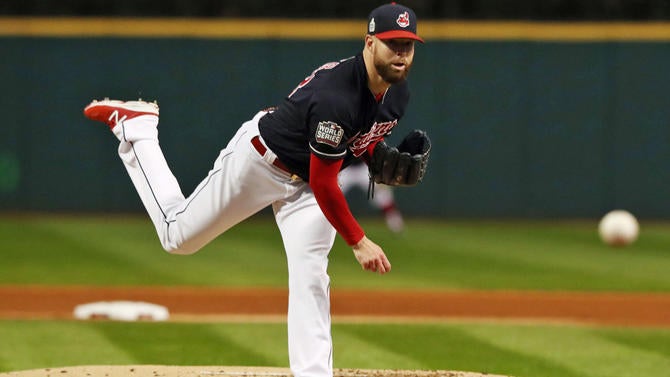
You wouldn't have known the Indians ace was working on three days' rest in Game 4 just by looking at him. Kluber plowed through six impressive innings Saturday night, allowing just a single run on five hits and one walk, striking out six and needing only 81 pitches to record those 18 outs.
Even if he's on a pitch limit again in Game 7, the Cubs should have reason to fear him. That's because Kluber has complemented his wipeout breaking ball with an unhittable two-seam fastball during this World Series. This Game 4 bit of wickedness against Baez exemplified the sharp, late break that Kluber's slider/curve/something or other can deliver. If Kluber can mix in the Greg Maddux-like two-seamer he unleashed in Game 1, the Cubs could be in trouble.
Kyle Hendricks gets another start in a closeout game.
Few pitchers in recent years pitched better in a playoff series-ending game than Hendricks did in Game 6 of the NLCS against the Dodgers. The soft-spoken right-hander outshone Clayton Kershaw in that contest, firing 7 1/3 dazzling innings, striking out six batters and allowing just two hits without a single walk. If that had been a regular-season game, Cubs skipper Joe Maddon probably would have let Hendricks try to go the distance, instead of pulling him after only 88 pitches.
The Cubs wound up losing Hendricks's first World Series start, though you could hardly blame him for that. Though he lasted only 4 1/3 innings, Hendricks worked around six hits and two walks, fanning six Indians and keeping the game scoreless. He found periodic success with his biting changeup, including this inning-ending dandy against Napoli. When he's going well, Hendricks brilliantly mixes that changeup with a bamboozling two-seamer of his own, a pitch that often doesn't even crack 90 mph, but still gives hitters fits. If Hendricks is on his game, the Indians might not necessarily strike out a ton; what they will do is hit a bunch of harmless grounders and popups, again and again.
Expect lots of Bryan Shaw, Andrew Miller, and Cody Allen.
The Indians' three headliner relievers never got into Game 6, a perfectly reasonable approach by Francona given how quickly the Cubs blew the game open. Between Kluber being a mortal lock to pitch better than Tomlin just did, and this being Game 7, Francona's likely going to use his big bullpen weapons as aggressively as humanly possible.
With another summer-like forecast on Wednesday (the projected high is 73 degrees; it was 71 at game time on Tuesday), the ball could carry well in Game 7. But the lethal sliders thrown by Shaw and Miller and the knuckle-curve of death offered by Allen could make squaring the ball up an extremely difficult task for Cubs hitters. If Chicago's going to pull this one out, you get the sense it might be something like a 3-2 or 2-1 final.
Expect more Aroldis Chapman. How much remains to be seen.
With two on and two out in the seventh and the middle of the Indians order coming up, Maddon summoned his triple-digit-pumping closer to douse the fire. That Chapman did, inducing an inning-ending groundout by Lindor that happened because the ace reliever actually hustled to first to cover this time, after botching a similar play in Game 5.
That decision to go to Chapman was defensible, even with a five-run lead. What made far less sense was bringing Chapman back out for the eighth, with that same five-run lead, not to mention a lineup full of sluggers who'd been swinging hot bats all night and had a chance to tack on more runs in the ninth. When Chapman closed out the eighth while needing only 15 pitches to record four outs, you had to figure that was certainly the point to offer a handshake and send him to the showers. Nope. Maddon inexplicably sent him back out for the ninth with a seven-run lead, watched as he walked leadoff hitter Brandon Guyer on five pitches, and only then finally decided to end Chapman's night.
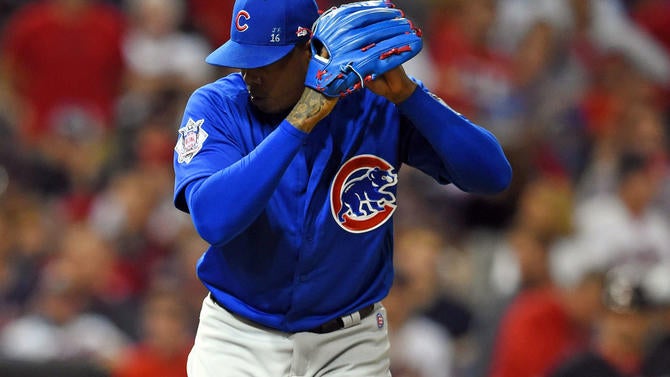
We can acknowledge that Maddon up close has a better feel for how strong his pitcher feels than we do from a distance. Still, the notion that Chapman should need to throw any more pitches with the Cubs up seven and three outs from victory boggles the mind. Maybe one more batter doesn't make a lick of difference in Game 7, and Chapman's able to give the Cubs two lights-out innings (or more), the way he did in Game 5. But if Chapman's ability to go long and strong was even slightly diminished by pitching near the end of a blowout, that's on Maddon for being at once too cute, and too frightened.
Jon Lester's probably going to get the ball.
With the caveat that Maddon almost surely won't go to him with a runner on first (and thus a huge threat to steal), expect Lester to see action at some point in Game 7. Even if it was just a subconscious move, it's possible that Maddon's cavalier approach to Chapman's Game 6 usage came with the knowledge that Lester -- and even Game 4 starter John Lackey -- could throw meaningful pitches in Game 7.
Jon Lester: "Tomorrow, there are no rules, no boundaries, no guidelines." Said he'll be available but hopes "nothing weird is needed." @MLB
— Jon Morosi (@jonmorosi) November 2, 2016
Combine those two potential starters-in-relief with Chapman's wipeout velocity, and a cast of thousands that could include underrated rookie Carl Edwards Jr., the short-relief tandem of Pedro Strop and Hector Rondon, lefty long man Mike Montgomery, and several others, and Maddon could deploy a kitchen sink approach similar to Francona's, making every at-bat an agonizing one for Cleveland.
The Indians outfield is bad. This could be a problem.
Michael Brantley's name might seem like a distant memory now that the calendar has flipped over to November. But Dr. Smooth was once an integral part of the Indians' attack, an All-Star left fielder who followed a brilliant .327/.385/.506 performance in 2014 with a .310/.379/.480 effort in 2015. Sadly, he lasted just 11 games this season, before a shoulder injury knocked him out 'til next spring.
Jose Ramirez has filled the lineup hole left behind by Brantley's putting up strikingly similar numbers. But the outfield has looked worse and worse as the season has gone on. Rookie Tyler Naquin started his rookie season hitting like a mad man, posting an off-the-charts .335/.399/.629 line through his first 70 big-league games. He's gone ice cold since then, batting just .234/.331/.331 from Aug. 1 to the end of the regular season, .190/.227/.286 in his first nine playoff games, then striking out twice in two at-bats Tuesday night, to go with his costly first-inning defensive miscue. Lonnie Chisenhall has looked rough defensively at times too, most notably in letting a Jorge Soler popup drop for a triple at Wrigley; he's also stopped hitting entirely since an impressive ALDS against the Red Sox, with just five hits in 30 at-bats. Coco Crisp has been the team's most productive outfielder this postseason, though you wonder if the smart bet is on the 37-year-old coming up big in Game 7, or reverting back to the mediocre form that produced an underwhelming .231/.302/.397 line this season.
The job that Francona and the Indians have done in getting this far is borderline miraculous, given the injuries suffered by Brantley, Carlos Carrasco, Danny Salazar, Yan Gomes, and other key contributors. In a winner-take-all scenario, you wonder if the Tribe has one more rousing performance left with their thinned-out roster, and their skeleton-crew outfield.
Nick Pollack of PitcherList.com contributed research help for this article.









